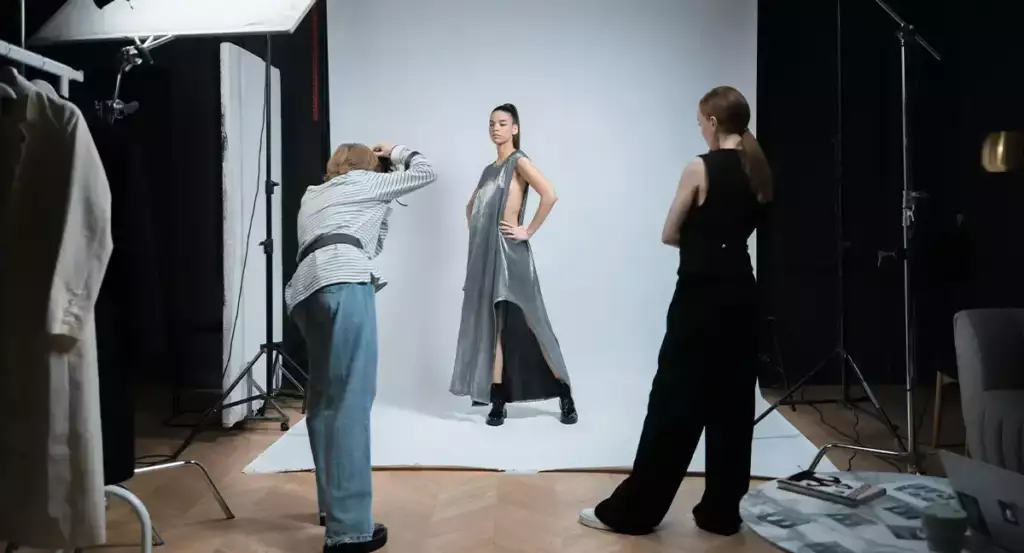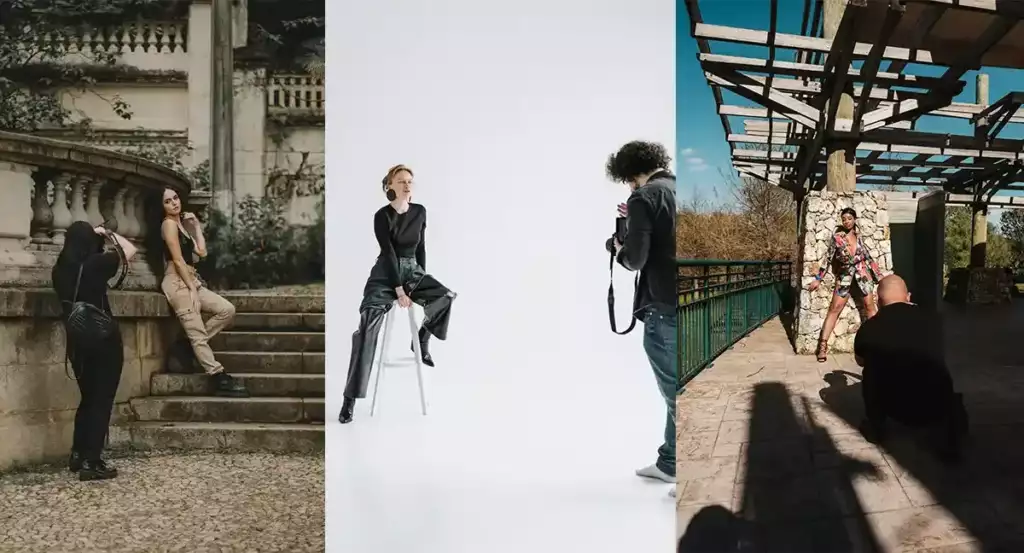
The Complete Guide To Model Photoshoot for Ecommerce Storefront
The Complete Guide To Model Photoshoot for Ecommerce Storefront
It won’t come as a surprise to you when I say “Visuals are responsible for creating 83% impact on the purchasing decision of your potential customers.”
With an uplift in the online shopping, the significance of high-quality product photos cannot be overlooked. A model photoshoot is a powerful tactic in showcasing products in a way that resonates with potential buyers, offering them a glimpse of how the products will look and feel in real life. This guide will take you through all the essential steps to plan, execute, and uplift your ecommerce storefront, ensuring your brand stands out and drives sales.
Why Photoshoots Matter for Ecommerce?
Building Brand Identity and Trust
Product photos being the primary touchpoint for your potential customers they play a really important role. A photoshoot helps build brand identity by reflecting the brand’s style, ethos, and values through carefully curated visuals. These images also foster trust; seeing a product worn or used by a model allows customers to visualize themselves using it, thereby increasing confidence in their purchase decisions.
Increasing Conversion Rates with Professional Photography
Studies show that high-quality images can significantly increase conversion rates. A well-executed photoshoot can highlight product details, show the item in context, and evoke an emotional response, all of which contribute to higher engagement and conversions. Professional photography, especially when it involves a model photoshoot, also minimizes the return rate, as customers have a better understanding of the product they’re purchasing.
Differentiating Your Brand from Competitors
Standing out in a saturated market is crucial. A unique and consistent visual style achieved through a photoshoot can set your brand apart from competitors. By showcasing your products in a distinct and appealing manner during a photoshoot, you not only attract potential customers but also create a memorable brand image that encourages repeat business.
How to Plan Your Model Photoshoot?
Identifying Your Target Audience and Brand Style
Before getting into the logistics of a photoshoot, it’s essential to have a clear understanding of your target audience. Who are they? What are their preferences? What problems are they trying to solve with your product? Understanding these aspects will guide you in choosing models, locations, and overall styling that resonates with your audience. Additionally, defining your brand’s visual style is key. Are you aiming for a sleek, modern look, or something more rustic and natural? This will influence everything from model selection to lighting and post-production.
Choosing the Right Models for Your Brand
The models you choose for your model photoshoot will be the face of your brand, so it’s critical to select individuals who align with your brand’s identity and appeal to your target audience. Consider diversity and inclusivity; today’s consumers value brands that represent a wide range of people. Look for models who not only fit the physical attributes you’re seeking but who can also convey the emotions and attitudes that align with your brand’s message.
Setting Goals and Expectations for the Shoot
Clear communication is important for a successful photoshoot. Set specific goals for what you want to achieve—whether it’s showcasing new product features, capturing seasonal styles, or creating content for a marketing campaign. Ensure that everyone involved, from photographers to stylists, understands these goals and works towards a cohesive final product. Setting expectations also involves practical aspects such as timelines, budgets, and deliverables, ensuring the project stays on track.
Preparation Before the Model Photoshoot

Location Scouting and Setting Up the Studio
The location of your model photoshoot sets the tone for your images. Depending on your brand’s style, you might choose a minimalist studio setup, an outdoor location, or a customized environment that mirrors your brand’s aesthetics. If shooting in a studio, consider how you can use props, backdrops, and lighting to create a dynamic and engaging visual narrative. For outdoor or on-location photoshoots, ensure that the environment aligns with the brand’s message and that you have contingency plans for weather or other unforeseen factors.
Wardrobe Selection and Styling Tips
The wardrobe chosen for the model photoshoot should not only complement the products but also enhance the overall brand image. Coordinate outfits with the product colors, themes, and the shoot’s setting. Consider hiring a stylist who understands fashion trends and can create looks that are both current and timeless. Accessories, hair, and makeup should all be aligned with the brand’s aesthetics to create a polished, cohesive look that will appeal to your target audience.
Assembling the Right Team: Photographers, Stylists, and Makeup Artists
A successful model photoshoot is the result of a collaborative effort. Choose a photographer who has experience in ecommerce and understands the nuances of capturing products in a way that is both artistic and commercially viable. A skilled stylist will ensure that the wardrobe, props, and overall look align with the brand’s image, while a professional makeup artist can enhance the models’ features to ensure they look their best under the camera’s scrutiny. Make sure each team member understands the brand’s vision and is on the same page regarding the photoshoot’s objectives.
Essentials While Executing the Model Photoshoot
Directing Models for the Best Shots
A crucial aspect of a successful photoshoot is the ability to direct models effectively. This involves guiding them on how to pose, where to look, and how to convey the right emotions. Effective communication is key—models should feel comfortable and confident, which will reflect in the final images. Experiment with different poses and expressions during the model photoshoot to capture a variety of looks that can be used across different marketing channels.
Capturing Various Angles and Poses
Diversity in shots is essential for creating a comprehensive visual story during photoshoot. Capture the product from multiple angles, and don’t be afraid to take close-ups as well as full-body shots. This approach provides flexibility in how the images can be used across your ecommerce site, from product pages to banners and social media. A mix of action shots, where the model is using or interacting with the product, and static poses during the model photoshoot will give you a wide range of visuals to choose from.
Lighting Techniques for Ecommerce Photography
Lighting can make or break a photoshoot. In ecommerce photography, the goal is to highlight the product’s features while maintaining a natural look. Soft, diffused lighting often works best as it minimizes shadows and creates a flattering, even tone. However, don’t be afraid to experiment with lighting angles and sources to add depth and interest to your photos. Ensure that the lighting setup is consistent across all shots to maintain a uniform look on your storefront.
Post-Photoshoot Processes

Photo Selection and Editing Tips
After the model photoshoot, the first step is to go through all the images and select the best ones that align with your brand’s goals. Look for photos that not only showcase the product but also capture the model in a way that is engaging and authentic. Once selected, the editing process begins. Basic edits include adjusting brightness, contrast, and color balance, but more advanced editing might involve retouching, background removal, and cropping to fit specific formats. The goal is to enhance the image while keeping it true to the product’s real-life appearance.
Ensuring Consistency Across Your Storefront
Consistency is key to a professional-looking ecommerce storefront. Ensure that all images from your model photoshoot have a uniform style, whether through consistent lighting, color tones, or editing techniques. This consistency helps in creating a cohesive brand experience, making your store more visually appealing and easier to navigate for customers. It also reinforces your brand identity, making it more recognizable across different platforms.
Preparing Images for Web Use (SEO, File Sizes, Formats)
Optimizing images from your photoshoot for web use is a crucial step in the post-production process. Large image files can slow down your website, negatively impacting user experience and SEO rankings. Compress images without losing quality, and use the appropriate file formats (e.g., JPEG for photographs, PNG for images with transparency). Additionally, include relevant keywords in your image file names and alt text to improve search engine visibility, helping potential customers find your products more easily.
Maximizing the Impact of Your Model Photoshoot
Integrating Photos into Your Ecommerce Site
Once your images from the photoshoot are ready, it’s time to integrate them into your ecommerce site. High-quality images should be prominently featured on product pages, category banners, and even the homepage. Consider how the images fit within the overall design and user experience of your site. For example, using large, high-resolution images on product pages allows customers to see details up close, while lifestyle images featuring models can be used in banners or promotional sections to create an emotional connection with your audience.
Using Model Images in Marketing Campaigns
Model photoshoot images are not just for your ecommerce site—they can be powerful tools in your marketing campaigns as well. Use these images in email newsletters, social media posts, and online ads to create a cohesive and recognizable brand presence. Ensure that the images from your photoshoot are aligned with the campaign’s goals and that they speak to your target audience’s needs and desires. Consistent use of model images across different marketing channels will reinforce your brand’s identity and keep it top-of-mind for consumers.
Analyzing Performance and Making Adjustments
After launching your images from the model photoshoot on your ecommerce site and marketing channels, it’s important to analyze their performance. Use tools like Google Analytics and heatmaps to see how users are interacting with the images. Are certain photos leading to higher conversions? Are customers spending more time on pages with specific types of images? Use this data to make informed decisions about future photoshoots and content strategy. Continuous optimization based on performance insights will help you get the most out of your visual content.
Case Study: Model Photoshoot
Gucci
Brand “Gucci” successfully increased their conversion rate after implementing a series of photoshoots that highlighted their new collection featuring Billie Eilish. By choosing models that resonated with their target audience and using a consistent visual style, they were able to create a cohesive brand experience that translated into higher sales.
Conclusion
Investing in professional model photoshoot is not just about creating beautiful images—it’s about building a strong, recognizable brand that resonates with your target audience. High-quality visuals enhance your ecommerce storefront, improve customer trust, and drive higher conversion rates. By following the steps outlined in this guide, you can plan, execute, and maximize the impact of a photoshoot, ensuring that your brand stands out in a crowded marketplace. Quality imagery is a powerful tool in the world of ecommerce, and it’s one that can significantly contribute to your brand’s success.

